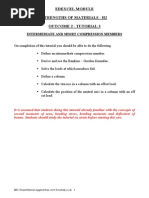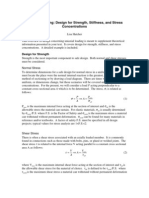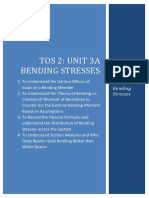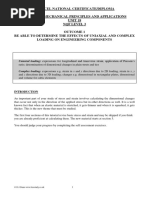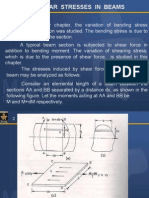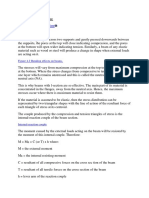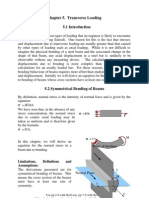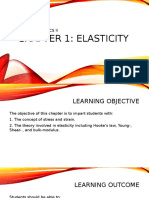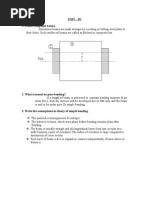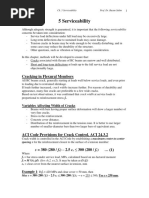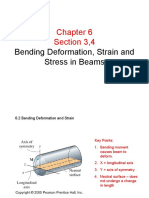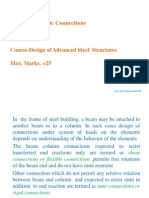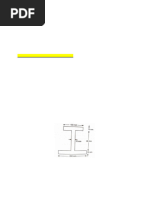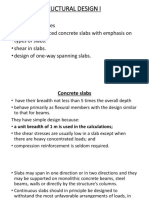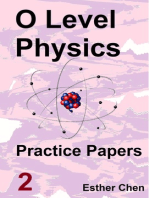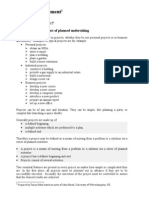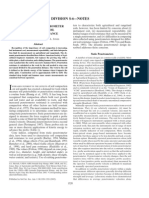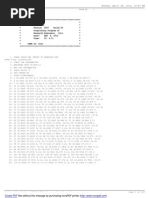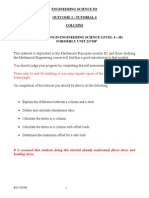Compression Members
Compression Members
Uploaded by
me-elormCopyright:
Available Formats
Compression Members
Compression Members
Uploaded by
me-elormCopyright
Available Formats
Share this document
Did you find this document useful?
Is this content inappropriate?
Copyright:
Available Formats
Compression Members
Compression Members
Uploaded by
me-elormCopyright:
Available Formats
D.J.
DUNN 1
ENGINEERING SCIENCE H1
OUTCOME 1 - TUTORIAL 4
COLUMNS
EDEXCEL HNC/D ENGINEERING SCIENCE LEVEL 4 H1
FORMERLY UNIT 21718P
This material is duplicated in the Mechanical Principles module H2 and those studying
the Mechanical Engineering course will find this a good introduction to that module.
You should judge your progress by completing the self assessment exercises.
These may be sent for marking or you may request copies of the solutions at a cost (see
home page).
On completion of this tutorial you should be able to do the following.
Explain the difference between a column and a strut.
Define and calculate slenderness ratio.
Calculate the stress in a column.
Calculate the stress in a column with offset loads.
Determine the maximum offset for a safe load.
It is assumed that students doing this tutorial already understand direct stress and
bending stress.
INTRODUCTION
Compression members are loaded in the direction of their length and not transversely (beams). They
may be long relative to their cross section in which case they are STRUTS or short in which case they
are COLUMNS. There is obviously an in between case called intermediate members. In this module
you are required to study columns but you do need to appreciate the difference.
STRUTS fail by bending and buckling so they very limited as a structural element.
COLUMNS fail in compression. In civil engineering they are often made of brittle material which is
strong in compression such as cast iron, stone and concrete. These materials are weak in tension so it is
important to ensure that bending does not produce tensile stresses in them. If the compressive stress is
too big, they fail by crumbling and cracking. Structural steel is also used as columns and the cross
section properties of standard rolled steel columns (RSC) are found in British Standard BS4 part 1. A
sample of this table is attached at the end.
Figure 1
2. SLENDERNESS RATIO
One way of deciding whether a compression member is long relative to its cross section is the use of
slenderness ratio. This is defined as:
k
L
S.R. =
L is the effective length and k is the radius of gyration for the cross sectional area. A strut is defined as
having a slenderness ratio is greater than 120 when made of steel and 80 when made of aluminium.
3. RADIUS OF GYRATION k
The radius of gyration is defined as
A
I
k =
I is the 2nd moment of area and A is the cross sectional area.
These properties may be looked up in tables for standard RSC but must be calculated for other sections.
D.J.DUNN 2
WORKED EXAMPLE No.1
Derive formulae for the radius of gyration of a circle diameter D and a rectangle width B and depth
D.
Circle
4
D
D 64
D 4
k
4
D
A
64
D
I
2
4 2 4
= = = =
Rectangle
12
12BD
BD
k BD A
12
BD
I
3 3
D
= = = =
WORKED EXAMPLE No.2
Calculate the slenderness ratio of a strut made from a hollow tube 20 mm outside diameter and 16
mm inside diameter and 1.2 metres long.
For a hollow tube the second moment of area is
( ) ( )
( ) ( )
5 . 187
mm 6.4
mm 1200
k
L
S.R.
mm 6.4
113.1
4637
A
I
k
mm 113.1
4
16 20
4
d D
A
4637mm
64
16 20
64
d D
I
2
2 2 2 2
4
4 4 4 4
= = =
= = =
=
=
=
=
SELF ASSESSMENT EXERCISE No.1
1. Find the radius of gyration and the slenderness ratio of a strut made from 5 m length of hollow
tube 50 mm outer diameter and 40 mm inner diameter.
(Ans 16 mm and 312.3)
D.J.DUNN 3
4. COMPRESSION STRESS
It is bad practise to apply a load at a point on brittle columns
because high local stress results in that region. A steel plate
should be used to spread the load over the section. Ideally the
load is applied at the centre of area and it is assumed that the
compressive stress spreads out evenly over the section. If the
load is F and the cross sectional area is A then the direct
(compressive) stress is
D
= -F/A (compression is negative)
F
5.
igure 2
SET LOADS OFF
the load is not applied at the centre of area, bending is induced in the
When the load is applied a distance 'x the centroid, a bending moment
mula for bending stress we have
B
= My/I
n
(compressive)
Figure 3
y/I - F/A
If
column and it is more likely to fail. Brittle columns in particular must not be
allowed to go into tension or they will crack. This is illustrated in figure 3.
' from
is induced in the column as shown. The bending moment is M = F x where
x is the offset distance.
From the well known for
y is the distance from the centroid to the edge of the colum .
The stress produced will be +ve (tensile) on one edge and -ve
on the other.
On the compressive edge this will add to the direct compressive stress making it larger so that
=
B
+
D
= -My/I - F/A
On the tensile edge the resulting stress is =
B
+
D
= M
A
F
I
Fx
=
y
akes buckling easier if the column is long enough to be
Substitute M = F x
Note that offset loads induce bending and m
affected by it.
WORKED EXAMPLE No.2
A column is 0.5 m diameter and carries a load of 500 kN offset from the centroid by 0.1m.
Calculate the extremes of stresses.
SOLUTION
F = 500 kN x = 0.1 m y = D/2 = 0.25 m
I = D
4
/64 = x 0.5 /4 = x 0.5
2
/4 = 0.196 m
2 4
/64 = 0.00307 m
4
A = D
2
D.J.DUNN 4
Tensile Edge MPa 1.52
0.196
500000 0.25 x 0.1 x 500000 Fxy
= = =
0.00307 A
F
I
Compressive Edge MPa 62 . 6
0.196
500000
0.00307
0.25 x 0.1 x 500000
A
F
I
Fxy
= = =
D.J.DUNN 5
. NEUTRAL AXIS 6
The neutral axis is the axis of zero stress. In the above example, the stress varied from 1.528 MPa on
one edge to -6.621 MPa on the other edge. Somewhere in between there must a value of y which makes
the stress zero. This does not occur on the centroid but is by definition the position of the neutral axis.
Ideally this axis should not be on the section at all so that no tensile stress occurs in the column. The
position of the neutral axis can easily be found by drawing a stress distribution diagram and then either
scaling off the position or calculate it from similar triangles.
WORKED EXAMPLE No.3
Determine the position of the neutral axis for the column in example 2.
SOLUTION
Drawing a graph of stress against position (y) along a diameter we get the figure shown (not drawn
to scale). If it is drawn to scale the position of the neutral axis may be scaled off.
Figure 5
Using similar triangles we arrive at the solution as follows.
A + B = 0.5
A = 0.5 - B
A/1.528 = B/6.621
(0.5 - B)/1.528 = B/6.621
3.3105 - 6.621B = 1.528 B
B = 0.406 m
7. MAXIMUM OFFSET
If a column must not go into tension, then the maximum offset may be calculated. Consider a circular
section first. The combined stress due to compression and bending is:
A
F
I
Fxy
=
If the edge must not go into tension then the maximum stress will be zero so:
y
Z
Ay
I
x) x(ma 0
A
F
I
Fxy
= = =
D.J.DUNN 6
D
2
/4 I = D
4
/64 and y = D/2 If we substitute we get For a round section A =
8 D/2 D 64
x(max)
2
= =
D D 4
4
The load must be no more than D/8 from the centroid.
If the column is a rectangular section I = BD
3
/12 A = BD and the critical value of y is D/2
6
D BD 2 I
x(max)
3
= = = when the off
D BD 12 Ay
set is on the short axis.
hen the offset is on the long axis x(max) is B/6 . This means the offset must be within the middle 1/3
f t middle third rule. The shaded area on the diagram shows the safe
gion for applying the load.
W
o he column and this is called the
re
Figure 6
For any standard section such as those in BS4, the maximum offset is easily found from x = Z/y
although for steel sections some tension is allowed.
WORKED EXAMPLE No.3
A column is made from an universal I section 305 x 305 x 97. A load of 2 MN is applied on the x
axis 200 mm from the centroid. Calculate the stress at the outer edges of the x axis.
If lumn is 5 m tall, what is th the co e slenderness ratio?
SOLUTION
T et is x = 0.2 m he offs and the load F = 2 MN
From
-8
m
-4
A = 123 x 10
-4
m
2
y = h/2 = 0.154 m the table I = 22249 x 10
MPa 439
10 x 123 I A I
4 -
c
10 x 2 54) )(0.2)(0.1
6 6
= = =
10 x (2 F Fxy
MPa 114
10 x 2 54) )(0.2)(0.1 10 x (2 F Fxy
6 6
T
= = =
10 x 123 I A I
4 -
There are two radii of gyration. k
x
= 0.134 k
y
= 0.0769 m
Slenderness Ratio about the x axis is = I/ k
x
= 37.3
Slenderness Ratio about the y axis is = I/ k
y
= 65
These are well below the limit of 120 for steel but the bending might cause collapse and would be
worth checking.
D.J.DUNN 7
SELF ASSESSMENT EXERCISE No.2
1. A column is 0.4 m diameter. It has a vertical load of 300 kN acting 0.05m from the centroid.
Calculate the stresses on the extreme edges.
(Answers 0 MPa and -4.77 MPa).
2. A column is 0.3 m diameter. Calculate the offset position of the load which just prevents the one
edge from going into tension. (Answer 0.038 m).
3. A column is made from a rectangular block of concrete with a section 600 mm x 300 mm. What is
the maximum offset of a point load that just prevents the edge going into tension.
(Answer 50 mm).
4. A column is made from cast iron tube 0.4 m outside diameter with a wall 40 mm thick. The top is
covered with a flat plate and a vertical load of 70 kN is applied to it. Calculate the maximum
allowable offset position of the load if the material must always remain in compression.
(Answer 0.082 m)
5. A hollow cast iron pillar, 38 cm outside diameter and wall thickness 7.5 cm, carries a load of 75 kN
along a line parallel to, but displaced 3 cm from, the axis of the pillar. Determine the maximum and
minimum stresses in the pillar.
What is the maximum allowable eccentricity of the load relative to the axis of the pillar if the
stresses are to be compressive at all points of the cross section?
6. A column is 4 m tall and made from an universal I section 152 x 152 x 23. A load of 60 kN is
applied on the x axis 110 mm from the centroid. Calculate the stress at the outer edges of the x
axis.
(35.2 MPa tensile and 45 MPa compressive, SL = 61 about the x axis and 108 about y axis)
D.J.DUNN 9
SAMPLE OF TABLE FOR UNIVERSAL COLUMNS WITH I SECTION
Thickness of Second Moment
Area
Radius
of Gyration
Elastic
Modulus
Plastic
Modulus
Designation
Mass
per
m
Depth
of
Section
Width
of
Section
Web Flange
Depth
between
Fillets
Root
Radius
Area
of
Section Axis
x-x
Axis
y-y
Axis
x-x
Axis
y-y
Axis
x-x
Axis
y-y
Axis
x-x
Axis
y-y
M h b s t r d A Ix Iy rx ry Zx Zy Sx Sy
kg/m mm mm mm mm mm mm cm
2
cm
4
cm
4
cm cm cm
3
cm
3
cm
3
cm
3
356x406x634 633.9 474.6 424 47.6 77 15.2 290.2 808 274845 98125 18.4 11 11582 4629 14235 7108
356x406x551 551 455.6 418.5 42.1 67.5 15.2 290.2 702 226938 82671 18 10.9 9962 3951 12076 6058
356x406x467 467 436.6 412.2 35.8 58 15.2 290.2 595 183003 67834 17.5 10.7 8383 3291 10002 5034
356x406x393 393 419 407 30.6 49.2 15.2 290.2 501 146618 55367 17.1 10.5 6998 2721 8222 4154
356x406x340 339.9 406.4 403 26.6 42.9 15.2 290.2 433 122543 46853 16.8 10.4 6031 2325 6999 3544
356x406x287 287.1 393.6 399 22.6 36.5 15.2 290.2 366 99875 38677 16.5 10.3 5075 1939 5812 2949
356x406x235 235.1 381 394.8 18.4 30.2 15.2 290.2 299 79085 30993 16.3 10.2 4151 1570 4687 2383
356x368x202 201.9 374.6 374.7 16.5 27 15.2 290.2 257 66261 23688 16.1 9.6 3538 1264 3972 1920
356x368x177 177 368.2 372.6 14.4 23.8 15.2 290.2 226 57118 20529 15.9 9.54 3103 1102 3455 1671
356x368x153 152.9 362 370.5 12.3 20.7 15.2 290.2 195 48589 17553 15.8 9.49 2684 948 2965 1435
356x368x129 129 355.6 368.6 10.4 17.5 15.2 290.2 164 40246 14611 15.6 9.43 2264 793 2479 1199
305x305x283 282.9 365.3 322.2 26.8 44.1 15.2 246.7 360 78872 24635 14.8 8.27 4318 1529 5105 2342
305x305x240 240 352.5 318.4 23 37.7 15.2 246.7 306 64203 20315 14.5 8.15 3643 1276 4247 1951
305x305x198 198.1 339.9 314.5 19.1 31.4 15.2 246.7 252 50904 16299 14.2 8.04 2995 1037 3440 1581
305x305x158 158.1 327.1 311.2 15.8 25 15.2 246.7 201 38747 12569 13.9 7.9 2369 808 2680 1230
305x305x137 136.9 320.5 309.2 13.8 21.7 15.2 246.7 174 32814 10700 13.7 7.83 2048 692 2297 1053
305x305x118 117.9 314.5 307.4 12 18.7 15.2 246.7 150 27672 9059 13.6 7.77 1760 589 1958 895
305x305x97 96.9 307.9 305.3 9.9 15.4 15.2 246.7 123 22249 7308 13.4 7.69 1445 479 1592 726
Thickness of Second Moment
Area
Radius
of Gyration
Elastic
Modulus
Plastic
Modulus
Designation
Mass
per
m
Depth
of
Section
Width
of
Section
Web Flange
Root
Radius
Depth
between
Fillets
Area
of
Section Axis
x-x
Axis
y-y
Axis
x-x
Axis
y-y
Axis
x-x
Axis
y-y
Axis
x-x
Axis
y-y
254x254x167 167.1 289.1 265.2 19.2 31.7 12.7 200.3 213 29998 9870 11.9 6.81 2075 744 2424 1137
254x254x132 132 276.3 261.3 15.3 25.3 12.7 200.3 168 22529 7531 11.6 6.69 1631 576 1869 878
254x254x107 107.1 266.7 258.8 12.8 20.5 12.7 200.3 136 17510 5928 11.3 6.59 1313 458 1484 697
254x254x89 88.9 260.3 256.3 10.3 17.3 12.7 200.3 113 14268 4857 11.2 6.55 1096 379 1224 575
254x254x73 73.1 254.1 254.6 8.6 14.2 12.7 200.3 93.1 11407 3908 11.1 6.48 898 307 992 465
203x203x86 86.1 222.2 209.1 12.7 20.5 10.2 160.8 110 9449 3127 9.28 5.34 850 299 977 456
203x203x71 71 215.8 206.4 10 17.3 10.2 160.8 90.4 7618 2537 9.18 5.3 706 246 799 374
203x203x60 60 209.6 205.8 9.4 14.2 10.2 160.8 76.4 6125 2065 8.96 5.2 584 201 656 305
203x203x52 52 206.2 204.3 7.9 12.5 10.2 160.8 66.3 5259 1778 8.91 5.18 510 174 567 264
203x203x46 46.1 203.2 203.6 7.2 11 10.2 160.8 58.7 4568 1548 8.82 5.13 450 152 497 231
152x152x37 37 161.8 154.4 8 11.5 7.6 123.6 47.1 2210 706 6.85 3.87 273 91.5 309 140
152x152x30 30 157.6 152.9 6.5 7.6 123.6 38.3 1748 560 6.76 222 9.4 3.83 73.3 248 112
152x152x23 23 15 15 5.8 7.6 12 29. 1250 6.54 164 182 2.4 2.2 6.8 3.6 2 400 3.7 52.6 80.2
D.J.DUNN 10
You might also like
- Simple Stress StrainDocument141 pagesSimple Stress Strainjs kalyana ramaNo ratings yet
- Tutorial 2 3Document0 pagesTutorial 2 3Muhammad SaeedNo ratings yet
- Complementary Shear StressDocument17 pagesComplementary Shear StresscataiceNo ratings yet
- Beam Tut4Document17 pagesBeam Tut4Cormos RaulNo ratings yet
- Tutorial 2 2 PDFDocument12 pagesTutorial 2 2 PDFAvish GunnuckNo ratings yet
- Civ1501 Engineering Statics Semester 2, 2002: Beam BendingDocument9 pagesCiv1501 Engineering Statics Semester 2, 2002: Beam BendingHundeejireenyaNo ratings yet
- Uniaxial Loading: Design For Strength, Stiffness, and Stress ConcentrationsDocument11 pagesUniaxial Loading: Design For Strength, Stiffness, and Stress ConcentrationsDanishIqbalNo ratings yet
- Bending StressDocument53 pagesBending StressManish Shashikant Dharek100% (9)
- Chapter 1Document50 pagesChapter 1AdzmierHassanNo ratings yet
- STRENGTH OF MATERIALS lecture 2 (1)Document7 pagesSTRENGTH OF MATERIALS lecture 2 (1)benivorentpeterNo ratings yet
- Fourth Lecture GEE 226Document16 pagesFourth Lecture GEE 226panamadivinefavourNo ratings yet
- Stress PDFDocument13 pagesStress PDF9966197483No ratings yet
- Stress and StrainDocument13 pagesStress and StrainMuruganandam RamadassNo ratings yet
- Theory of Simple Bending - Full1Document62 pagesTheory of Simple Bending - Full1Rahul KasaudhanNo ratings yet
- Diploma Strength of Materials 5th UnitDocument30 pagesDiploma Strength of Materials 5th UnitSuresh BalamNo ratings yet
- Unit 3a Spanning Members - Beams - Bending StressesDocument10 pagesUnit 3a Spanning Members - Beams - Bending StressesTanvi KhochareNo ratings yet
- Simple Stress StrainDocument141 pagesSimple Stress StrainvelavansuNo ratings yet
- Stress and StrainDocument10 pagesStress and StrainZIZIPHO MNTUMNINo ratings yet
- ECS 238 - Chapter 1 (Stress and Strain)Document131 pagesECS 238 - Chapter 1 (Stress and Strain)dixn__No ratings yet
- Design For Flexure-WsdDocument10 pagesDesign For Flexure-WsdRichard TagleNo ratings yet
- C 5 Shear Stress TDocument18 pagesC 5 Shear Stress TSuyash ToshniwalNo ratings yet
- Beams and ColumnsDocument44 pagesBeams and ColumnsMani KrishnaNo ratings yet
- RC2009 University of HongKong Reinforced Concrete DesignDocument29 pagesRC2009 University of HongKong Reinforced Concrete DesignApril IngramNo ratings yet
- Mech Sol ch7Document16 pagesMech Sol ch7akshatbhargavaNo ratings yet
- Structural MembersDocument14 pagesStructural MemberscataiceNo ratings yet
- Torsion of Circular Sections: Recitation #6 October 14, 2003Document12 pagesTorsion of Circular Sections: Recitation #6 October 14, 2003Krm ChariNo ratings yet
- Tensile Stress: AnswerDocument22 pagesTensile Stress: Answeramiel_togleNo ratings yet
- Chapter 5 (Stresses in Beams)Document42 pagesChapter 5 (Stresses in Beams)Jerson Alo SabanalNo ratings yet
- Machine Design I Learning Module I: Stress Analysis: Authored By: Engr. Ronnie Tavares Rat/8/17/2013/8:55 PMDocument32 pagesMachine Design I Learning Module I: Stress Analysis: Authored By: Engr. Ronnie Tavares Rat/8/17/2013/8:55 PMOtil SeravatNo ratings yet
- 2 - Flexural Beam (WSD or ASD)Document24 pages2 - Flexural Beam (WSD or ASD)Yusf RwandzyNo ratings yet
- Structural Analysis-I-Summer-13Document2 pagesStructural Analysis-I-Summer-13harnishtanna21285No ratings yet
- Lecture # 6 Stresses in BeamsDocument44 pagesLecture # 6 Stresses in Beamsabcheema112No ratings yet
- Strenght of Materials: DR As Shote DR Ob OlatundeDocument60 pagesStrenght of Materials: DR As Shote DR Ob OlatundeTimothy PromiseNo ratings yet
- Ch1 Elasticity (1) UthmDocument34 pagesCh1 Elasticity (1) UthmNordiana IdrisNo ratings yet
- Unit 3Document15 pagesUnit 3Mazzello FrancisNo ratings yet
- Structural Members: Struts and Ties Direct Stress and Strain, Dimensional ChangesDocument6 pagesStructural Members: Struts and Ties Direct Stress and Strain, Dimensional ChangescataiceNo ratings yet
- Column Design EC2Document41 pagesColumn Design EC2Azrai AzizNo ratings yet
- Chapter-1, Simple StressDocument71 pagesChapter-1, Simple Stresssherlockhisham100% (2)
- Thermal Stress ExamplesDocument10 pagesThermal Stress ExamplesVishal V BhagwatNo ratings yet
- Stress and Strain RenewDocument65 pagesStress and Strain Renewshafarizy100% (1)
- 5 Serviceability 22Document9 pages5 Serviceability 22Tara NahroNo ratings yet
- Lecture 3Document30 pagesLecture 3M.H100% (1)
- 2 T 2Document14 pages2 T 2PuligalNo ratings yet
- Section 3,4: Bending Deformation, Strain and Stress in BeamsDocument20 pagesSection 3,4: Bending Deformation, Strain and Stress in BeamsVinayak ImadiNo ratings yet
- Eccentric ConnecctionsDocument41 pagesEccentric ConnecctionsShyam Suryawanshi100% (1)
- Chapter 3 StressDocument145 pagesChapter 3 Stressataberk-ozkayaNo ratings yet
- QB U2 (Notes) (Bhartimumbai)Document3 pagesQB U2 (Notes) (Bhartimumbai)kaustubh7907No ratings yet
- Uniaxial Loading: Design For Strength, Stiffness, and Stress ConcentrationsDocument11 pagesUniaxial Loading: Design For Strength, Stiffness, and Stress Concentrationsabhi aroteNo ratings yet
- Slab DesignDocument45 pagesSlab DesignOkino CharlesNo ratings yet
- Concrete CalculationDocument10 pagesConcrete CalculationKaye Ibañez CastilloNo ratings yet
- O level Physics Questions And Answer Practice Papers 2From EverandO level Physics Questions And Answer Practice Papers 2Rating: 5 out of 5 stars5/5 (1)
- Cylindrical Compression Helix Springs For Suspension SystemsFrom EverandCylindrical Compression Helix Springs For Suspension SystemsNo ratings yet
- Dynamic Damage and FragmentationFrom EverandDynamic Damage and FragmentationDavid Edward LambertNo ratings yet
- Standard-Slope Integration: A New Approach to Numerical IntegrationFrom EverandStandard-Slope Integration: A New Approach to Numerical IntegrationNo ratings yet
- Project ManagementDocument36 pagesProject Managementnoahzgambo319378% (9)
- Admix CF 333 HDocument2 pagesAdmix CF 333 Hme-elormNo ratings yet
- Chemical EquationsDocument10 pagesChemical Equationsme-elormNo ratings yet
- New Perspectives in Astrophysical Cosmology: Second EditionDocument23 pagesNew Perspectives in Astrophysical Cosmology: Second Editionme-elormNo ratings yet
- Herrick Jones 2002 PenetrometerDocument5 pagesHerrick Jones 2002 Penetrometerme-elormNo ratings yet
- TRUSS Analysis and DesignDocument150 pagesTRUSS Analysis and Designme-elormNo ratings yet
- Compression MembersDocument9 pagesCompression Membersme-elormNo ratings yet


